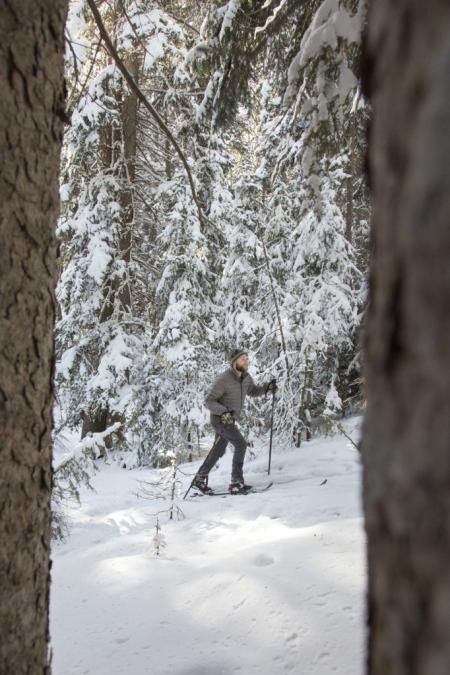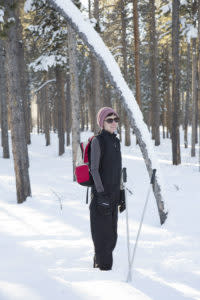Cross Country Skiing For Beginners
by Dani and Brian Harrington, photos courtesy of Brian Harrington
If you’re wondering how to increase the time you spend outdoors during the winter months, cross country skiing is a fun way to experience nature while also sneaking in a good workout. Cross-Country skiing around Laramie is a spectacular home base for the sport: groomed trails in charming alpine forests await you to the east (Tie City Trailhead), southwest (Chimney Park trails), and the west (Barber Lake and Libby Creek trails). Some areas are as close as 12 miles and none are further than 40.
While becoming an expert nordic skier takes years, the good news is that the sport is easy to enter and enjoy at the beginner level. Gliding along groomed trails as you take in the beautiful scenery and fresh air, even with a low level of proficiency, is an invigorating experience and a great way to beat the winter blues.
Still, your first time out could be frustrating or even unsafe if you are unprepared or don’t have the right gear. Below, we offer some beginner tips for cross country skiing.
 Tip #1: Don’t Skimp on Gear
Tip #1: Don’t Skimp on Gear
Take it from someone who for years used her mom’s old, too-big cross country skiing equipment: having quality, correctly sized gear makes all the difference. You’ll be doing yourself a huge favor by renting (and maybe eventually purchasing) a modern set of skis, boots, and poles. Touring skis are the most common for cross country skiing and are the most beginner-friendly. Opt for waxless.
Ensuring that your equipment is properly sized will make your learning experience comfortable, safer, and more instructive. For this reason, it is a great idea to stop by Fast Haus Ski & Bike, Laramie’s Basecamp or Westgate Sports where you can rent equipment with the help of a professional.
Tip #2: Dress in Layers
Proper clothing is key to your safety, comfort, and therefore your overall experience. A wind-resistant top layer paired with athletic clothing made of wool or other moisture-wicking fabrics is your best bet (avoid cotton as it tends to hold moisture). A hat and gloves are both necessities, and if conditions are extra cold, I love to use air-activated hand and toe warmers.
Adding and subtracting layers is the best way to ensure that you maintain a comfortable temperature. Pack your shedded layers in a backpack along with water, a few snacks, sunscreen, and sunglasses.
Tip #3: Kick-and-Glide in Classic Stride
 Cross country skiing can generally be split into two distinct styles: classic and skate. Skate skiing involves making v-patterns as you push off each ski, similar to rollerblading or ice skating. Classic, on the other hand, involves a diagonal stride.
Cross country skiing can generally be split into two distinct styles: classic and skate. Skate skiing involves making v-patterns as you push off each ski, similar to rollerblading or ice skating. Classic, on the other hand, involves a diagonal stride.
Most people start out with classic because the basic movement of the classical style is akin to walking, with an added kick-and-glide motion. The kick-and-glide is the foundation of classic cross country skiing. Simply push off one ski with a kick stride and glide forward with the other, repeating the process over and over again. While mastering this technique takes time, you’ll find the basic movement relatively intuitive, naturally using your poles to maintain your balance.
Located off I-80, the Happy Jack/Tie City Trailhead just 12 miles east of Laramie boasts the most well-groomed trails, so we recommend this location for trying out your skills. The Ridge, Meadow, and Adler Trails are great loops for beginners as they are relatively flat.
 Tip #4: Learn a Few Basic Techniques
Tip #4: Learn a Few Basic Techniques
In addition to the kick-and-glide motion, you will want to learn a few more techniques, especially as you gain confidence and try new trails.
Use the herringbone technique when you encounter hills that are too steep to climb with a kick-and-glide motion. As you notice yourself starting to slip backward, it’s time to use the herringbone. The herringbone involves forming a loose v-shape with your skis, pointing the tips of your skis outward while angling the inside edges of your skis down. This angling allows you to dig into the snow, giving you the necessary traction to walk up the hill. Use your poles to help push yourself up, too.
On the flip side, the snowplow or pizza technique will help you safely descend hills. Although going down long, gentle slopes is generally fun and easy, steeper hills call for the snowplow. This snowplow technique helps you reduce speed. To do the snowplow, angle the tips of your skis inward to form a v-shape where the tips of your skis loosely mirror the point of the v. Keep the inside edges of your skis angled downwards.
Even on beginner trails, both the herringbone and the snowplow may come in handy.
Tip #5: Safety First
While cross country skiing is a relatively tame sport, it still has its share of dangers. Make sure that you are properly dressed to avoid frostbite and hypothermia. Skiing with a friend is also a good idea, especially if you are going longer distances or skiing in a less popular area. Twisting an ankle or knee alone and in frigid temperatures could be a disaster.
Also, take care to be aware of your surroundings. As a beginner, you’ll likely have a tendency to focus your gaze on your feet, but remember to look up frequently to avoid crashes with other skiers, who could be coming at you from several directions. Simply being aware of what’s happening around you should prevent any unfortunate mishaps.
Tip #6: Embrace the Experience
 Remember to relax. Your first trip out might feel intimidating, but stiffening up will only make your experience more difficult and less enjoyable. Bend your knees, flex your ankles, and use your core. Take breaks as needed (it’s a fine time to enjoy a snack). Accept that falls happen.
Remember to relax. Your first trip out might feel intimidating, but stiffening up will only make your experience more difficult and less enjoyable. Bend your knees, flex your ankles, and use your core. Take breaks as needed (it’s a fine time to enjoy a snack). Accept that falls happen.
It’s natural that you’ll feel frustrated at times, but overall, each stage in your development will be fun, from beginner to expert.
Click here for more information on Cross Country Skiing in Laramie.
Note: Brian and Dani Harrington are independent writers contracted by Visit Laramie. Views and opinions expressed here are their own and do not reflect those of the Albany County Tourism Board.

